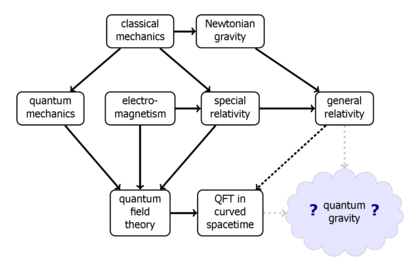https://en.wikipedia.org/wiki/CGh_physics
cGh physics
cGh physics refers to the mainstream attempts in physics to unify relativity, gravitation and quantum mechanics, in particular following the ideas of Matvei Petrovich Bronstein and George Gamow. The letters are the standard symbols for the speed of light (c), the gravitational constant (G), and Planck's constant (h).If one considers these three universal constants as the basis for a 3-D coordinate system and one envisions a cube, then this pedagogical construction provides a framework referred to as the "cGh cube" or "physics cube". This cube can used for organizing major subjects within physics as occupying each of the eight corners.
The eight corners of the cGh physics cube are:
- Classical mechanics (_,_,_)
- Special relativity (c,_,_), Gravitation (_,G,_), Quantum mechanics (_,_,h)
- General relativity (c,G,_), Quantum field theory (c,_,h), Non-relativistic quantum theory with gravity (_,G,h)
- Theory of everything, or relativistic quantum gravity (c,G,h)

In popular culture
- George Gamow chose "C. G. H." as the initials of his fictitious character, Mr C. G. H. Tompkins.
Matvei Petrovich Bronstein - Wikipedia, the free encyclopedia
Matvei Petrovich Bronstein (Russian: Матвей Петрович Бронштейн, December 2 [O.S. November 19] 1906, Vinnytsia — February 18, 1938) was a Soviet theoretical physicist, a pioneer of quantum gravity, author of works in astrophysics, semiconductors, quantum electrodynamics and cosmology, as well as of a number of books in popular science for children.
He introduced the cGh scheme for classifying physical theories. "After the relativistic quantum theory is created, the task will be to develop the next part of our scheme, that is to unify quantum theory (with its constant h), special relativity (with constant c), and the theory of gravitation (with its G) into a single theory."
------------------------------------------
The Physics Cube, C.J. Wainwright
Maths and Physics > The Physics Cube
The universe is goverened by three fundamental constants: The speed of
light, c, Planck's constant, h, and Newton's gravitational constant, G.
Advances in theoretical physics can be seen as a journey around a cube representing
which of these constants we choose to include in our theories and which
we choose to ignore. The ultimate goal is to include all three constants
consistently in a theory of quantum gravity.
----------------
Gorelik, Gennady (1992-01-01). "Studies in the history of general relativity: First Steps of Quantum Gravity and the Planck Values". Einstein Studies (Birkhäuser Boston) 3 (1): 364–379. Retrieved 2009-05-01.
------------------
Duff, Michael; Lev B. Okun; Gabriele Veneziano (2002). "Trialogue on the number of fundamental constants". Journal of High Energy Physics (3). arXiv:physics/0110060. Bibcode:2002JHEP...03..023D. doi:10.1088/1126-6708/2002/03/023.
Trialogue on the number of fundamental constants
(Submitted on 20 Oct 2001 (v1), last revised 13 Sep 2002 (this version, v3))
This paper consists of three separate articles on the number of fundamental dimensionful constants in physics. We started our debate in summer 1992 on the terrace of the famous CERN cafeteria. In the summer of 2001 we returned to the subject to find that our views still diverged and decided to explain our current positions. LBO develops the traditional approach with three constants, GV argues in favor of at most two (within superstring theory), while MJD advocates zero.
-----------------------------
Okun, Lev (1991-01-01). "The fundamental constants of physics". Soviet Physics Uspekhi (Sov. Phys. Usp.) 34 (9): 818–826. Bibcode:1991SvPhU..34..818O. doi:10.1070/PU1991v034n09ABEH002475. PACS 06.20.Jr.
--------------------------------------------
http://xxx.lanl.gov/abs/hep-ph/0112339
[hep-ph/0112339] Cube or hypercube of natural units
http://xxx.lanl.gov/abs/hep-ph/0112339
Cube or hypercube of natural units
http://xxx.lanl.gov/abs/hep-ph/0112339
Cube or hypercube of natural units
(Submitted on 27 Dec 2001)
Max Planck introduced four natural units: h, c, G, k. Only the first three of them retained their status, representing the so called cube of theories, after the theory of relativity and quantum mechanics were created and became the pillars of physics. This short note is a little pebble on the tombstone of Michael Samuilovich Marinov.
---------------------------------------------------------------------------------


No hay comentarios:
Publicar un comentario